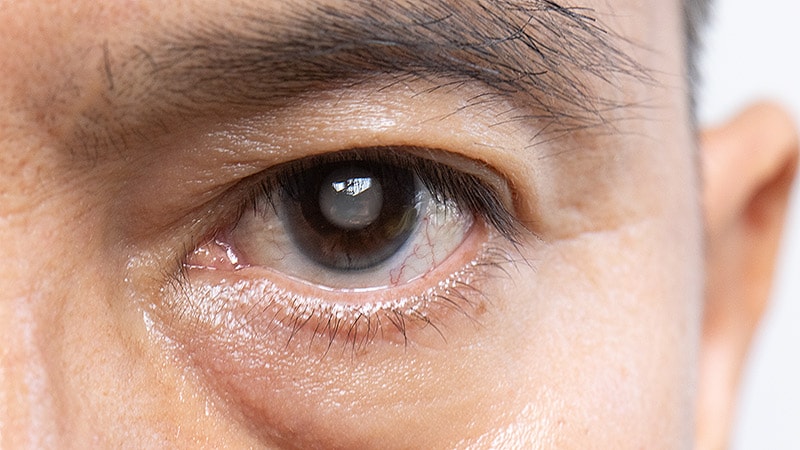ORLANDO, Fla. — The old, generic cholesterol drug fenofibrate has shown potential for slowing the progression of diabetic retinopathy in people with early retinal changes, with the potential to reduce the need for retinal laser or intravitreal injection treatment, new trial data suggest.
In the multicenter LENS trial of more than 1100 people randomly assigned to fenofibrate or placebo for 4 years, fenofibrate led to a 27% reduction in the progression of, or treatment for, diabetic retinopathy or maculopathy. The benefit was seen in people with both type 1 and type 2 diabetes and in those with both normal and impaired kidney function.
"We'll be watching to see what might happen with uptake in routine care with repurposing of an old drug…The point is trying to prevent people from needing [retinal laser and intravitreal injection]. Those treatments have significant downsides. With this drug, if it works, the aim would be to use it early to reduce the numbers of people progressing to need treatment," lead author David Preiss, PhD, told Medscape Medical News.
Preiss, associate professor at Oxford Population Health, University of Oxford, UK, presented the LENS results June 21 at the American Diabetes Association's annual Scientific Sessions. The data were published simultaneously in NEJM Evidence.
Fenofibrate's effects on diabetic retinopathy were seen in two previous cardiovascular outcomes trials: in a 2007 substudy of the 2005 FIELD study and in a 2010 analysis of data from the ACCORD study. LENS is the first dedicated study investigating fenofibrate's effect on diabetic retinopathy outcomes, Preiss noted.
Asked to comment, session moderator Thomas W. Gardner, MD, professor of ophthalmology and physical sciences and internal medicine at the University of Michigan, Ann Arbor, told Medscape Medical News, "I think this is very encouraging. It totally fits the previous findings…It suggests that the progression of retinopathy can be lowered by not 100%, but by a third, maybe, which is substantial. Every little bit helps. And it can be done with a very safe drug, a very inexpensive drug that's taken by mouth."
Gardner added, "Just controlling A1c isn't the whole story…When people have some microaneurysms or a few small hemorrhages, for which there's no ocular treatment, then having a systemic therapy like fenofibrate would seem to make a lot of sense."
Fenofibrate Reduced Progression by 27%
The 16-center trial was embedded into routine clinical care at 11 National Health Service centers in Scotland, from September 2018 through July 2021. A total of 1151 participants with either mild background retinopathy or maculopathy were randomly assigned to receive 145 mg fenofibrate or placebo either daily or every other day in those with impaired kidney function. Complete data were available for 1149 participants. Of those, 27% had type 1 diabetes and 23% had an estimated glomerular filtration rate (eGFR) <60 ml/min/1.73 m2.
The primary outcome was time to the first occurrence of the composite of developing referable diabetic retinopathy or maculopathy, or treatment for diabetic retinopathy or maculopathy (including intravitreal injection of medication, retinal laser therapy, or vitrectomy) in either eye. During the treatment period, that outcome occurred in 22.7% of the fenofibrate group vs 29.2% with placebo, a significant difference (hazard ratio 0.73, P =.006).
The occurrence of any retinopathy or maculopathy progression was also significantly less common with fenofibrate, 32.1% vs 40.2% with placebo (hazard ratio [HR], 0.74), as was referral for treatment, 18.6% vs 25.9% with placebo (HR, 0.66). Macular edema occurred in 3.8% with fenofibrate vs in the 7.5% placebo group, also significant (HR, 0.50).
There were no differences between the two groups in visual function, quality of life, or visual acuity. This isn't surprising, since these individuals had early retinopathy without visual impairment, Preiss pointed out.
Results were similar for participants with type 1 and type 2 diabetes, and those with normal vs impaired renal function.
Safety: No Major Concerns
There was no difference between groups in major cardiovascular events or nontraumatic lower limb amputations, and no effect on urine albumin:creatinine ratio, or in total cholesterol or non-HDL cholesterol. Triglyceride levels were a significant 13.7% lower with fenofibrate.
The eGFR was 7.9 ml/min/1.73 m2 lower in the fenofibrate group on average throughout the study, a significant difference. But, Priess noted, this effect was reversible.
"It's well recognized that fenofibrate on average puts your blood creatinine levels up about 15%...It's completely reversible. So if you stop the drug 4 weeks later, your renal function is back to where it was. In fact, after 5 years, [the FIELD study] suggested it might even be renoprotective," Preiss told Medscape.
In fact, he added, "If somebody who is not used to the drug sees the renal function, they may incorrectly assume that it's giving renal harm when in fact it's not. It's entirely reversible, but you have to be aware of it so that you take it into account when you're looking at your patient's kidney function, because otherwise you might assume that it's harming the kidney when in fact, it's highly likely to not be, and it may be renoprotective…It is a little quirk which will require some subtlety in clinical management."
He added that his team will now follow eye and kidney function in these trial participants for the next 10 years.
Both Preiss and Gardner told Medscape that two additional, ongoing randomized trials are expected to add further support for the use of fenofibrate in people with early diabetic retinopathy. One, the 3-year FAME 1 EYE trial, is taking place in Australia, where fenofibrate has been approved to slow progression of diabetic retinopathy in people with type 2 diabetes since 2013.
The other, Protocol AF, is evaluating about 560 patients with either type 1 or type 2 diabetes who have mild to moderately severe nonproliferative diabetic retinopathy and no center-involved diabetic macular edema. The 6-year trial will also evaluate the feasibility of a model where ophthalmologists prescribe or collaborate with primary care or endocrinologists to prescribe fenofibrate and monitor patients.
Gardner pointed out that it might take time for the ophthalmology community to embrace a systemic treatment for early retinopathy. "No company is out marketing this drug and educating physicians and ophthalmologists about it. You go to an ophthalmology meeting, there's nothing about this so far. There will be some certainly, but…eye surgeons are incentivized to treat advanced-stage disease. They're not incentivized to take care of patients who have a couple of microaneurysms."
But, he said, "I think if I was seeing a patient with some mild background retinopathy now and whether their control was perfect or not perfect, I would certainly present it to them."
LENS was primarily funded by the National Institute for Health and Care Research (NIHR), Health Technology Assessment Programme. The Nuffield Department of Population Health (NDPH), University of Oxford, covered the costs of storing, packaging, and preparation for mailing of trial treatment. LENS is coordinated by the Clinical Trial Service Unit and Epidemiological Studies Unit (CTSU), NDPH, University of Oxford; CTSU receives funding from the UK Medical Research Council (MRC), the British Heart Foundation, and Health Data Research (HDR) UK. During the conduct of the trial, Preiss was also supported by a University of Oxford BHF Centre of Research Excellence Senior Transition Fellowship, MRC and HDR UK.
Gardner report no relevant financial relationships.
Miriam E. Tucker is a freelance journalist based in the Washington, DC area. She is a regular contributor to Medscape, with other work appearing in The Washington Post, NPR's Shots blog, and Diatribe. She is on X (formerly Twitter) @MiriamETucker.

.webp) 4 days ago
6
4 days ago
6


























 English (US)
English (US)